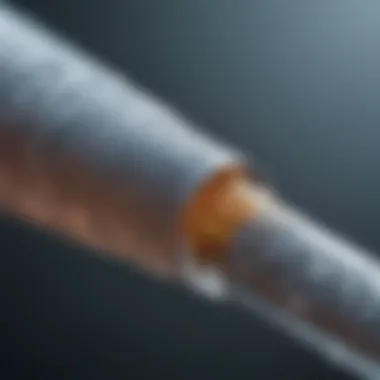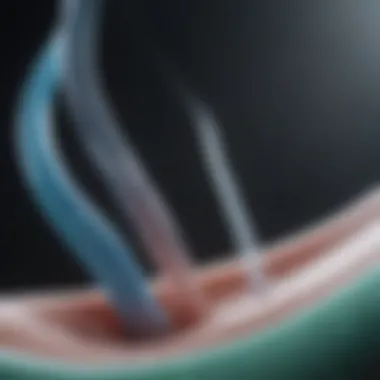Understanding the Best Hydrophilic Catheters


Intro
In recent years, hydrophilic catheters have gained significant attention in the medical field. These devices are essential for a variety of procedures where catheterization is necessary. Understanding them is crucial for both healthcare professionals and patients alike. Hydrophilic catheters are designed to provide reduced friction during insertion and enhanced comfort, making them a preferable choice in clinical settings.
Hydrophilic catheters are coated with a special material that becomes slippery when hydrated. This property allows for smoother insertion, which can lead to decreased pain and discomfort during use. Additionally, these catheters are often used for urinary management, intravenous access, and other medical applications. The materials used in their construction can vary, influencing performance and user preference. This article will delve into the composition, applications, and characteristics that define the best hydrophilic catheters.
Research Overview
Summary of Key Findings
Recent research has highlighted several vital aspects of hydrophilic catheters that influence their effectiveness and user satisfaction. Key findings include:
- Comfort: Users report significantly higher comfort levels with hydrophilic catheters compared to traditional options.
- Safety: Reduced friction leads to lower risks of urethral injury and infection, enhancing patient safety.
- Performance: The effectiveness in different medical scenarios varies, with some designs exhibiting superior attributes in specific applications.
Relevance to Current Scientific Discussions
The importance of hydrophilic catheters is not limited to their immediate benefits. They are a focal point in ongoing discussions regarding patient-centered care. With a shift toward prioritizing patient comfort, products like hydrophilic catheters exemplify how medical materials can evolve to meet clinical needs more effectively. Healthcare professionals must stay informed about advancements in catheter technology to optimize patient outcomes.
Methodology
Research Design and Approach
The research regarding hydrophilic catheters encompasses both qualitative and quantitative approaches. Surveys and clinical trials provide valuable data on user experiences and performance metrics. Furthermore, comparative studies assess various brands and their effectiveness across different medical settings.
Data Collection and Analysis Techniques
Data collection methods include:
- Surveys distributed to healthcare providers and patients
- Clinical trials measuring pain levels and comfort during catheterization
- Analysis of infection rates associated with different catheter types
Data is typically analyzed using statistical methods to ascertain significant differences in outcomes between hydrophilic and traditional catheter options. Results from this analysis help formulate recommendations for the best practices in catheter use.
Preamble to Hydrophilic Catheters
The topic of hydrophilic catheters holds significant importance in modern medical practice. This article aims to provide a thorough understanding of these specialized devices and their critical role in enhancing patient care. Hydrophilic catheters are designed to minimize friction when inserted into the body, facilitating smoother procedures and improving overall patient comfort.
The benefits of using hydrophilic catheters are manifold. They reduce trauma to the urethra or other insertion sites, which is crucial for ensuring a positive patient experience. Traditionally, catheters have been known to cause discomfort and pain, but hydrophilic options have been developed to address these concerns. This shift towards patient comfort is an essential consideration in healthcare, where the emphasis on improving patient outcomes cannot be overstated.
Additionally, the mechanisms of hydrophilic catheters operate on the basis of a unique coating that becomes slippery when moistened. This innovation not only promotes ease of insertion but also lowers the risk of complications such as strictures and urinary tract infections. The careful design and technology involved in creating these catheters reflect the ongoing evolution within the field of urology and other medical specialties.
As awareness about these devices increases, understanding their specific applications and features becomes increasingly relevant. This article will explore elements like material composition, innovative designs, advancements in technology, and user-friendly features. By breaking down these aspects, we aim to inform and educate medical professionals about how to choose the best options available.
In summary, this introduction sets the stage for a detailed examination of hydrophilic catheters. Understanding their function and benefits is essential for medical practitioners, researchers, and patients alike. An in-depth exploration of hydrophilic catheters will follow, focusing on their clinical applications and advantages in contrast to traditional options.
"Hydrophilic catheters exemplify the progress in medical device technology aimed at reducing patient discomfort and improving clinical outcomes."
Ultimately, the journey into the world of hydrophilic catheters reflects a broader commitment to quality care in medicine. Knowing the intricacies of these tools can enhance patient experiences and outcomes, shaping the future of catheter use.
What Are Hydrophilic Catheters?
Hydrophilic catheters are specialized medical devices designed to facilitate the transportation of fluids within the body. Their significance lies in their ability to enhance patient care through improved comfort and reduced complications. The unique properties of these catheters result from their hydrophilic coating, allowing for smoother insertion and a decrease in friction against biological tissues. These attributes can therefore lead to better clinical outcomes in various procedures.
Definition and Function
A hydrophilic catheter is defined primarily by its surface properties. The hydrophilic coating absorbs water, creating a slippery surface that diminishes friction. This design enhances the ease of use for both medical professionals and patients. Furthermore, the primary function of these catheters involves the accurate delivery of fluids, whether that be for urinary, vascular, or other medical purposes. Their capacity to facilitate easier insertion can help prevent trauma to the urethra or other sensitive structures, ultimately promoting patient comfort during the procedure.
In clinical practice, the choice of using a hydrophilic catheter often relates to the specific needs of the patient. For instance, individuals who may have experienced pain or discomfort with traditional catheters may find hydrophilic options provide better experiences. Patient preferences can also influence the selection of catheter types, leading to a growing adoption of hydrophilic designs.
Comparison with Traditional Catheters
When comparing hydrophilic catheters with traditional catheters, several distinctive differences become apparent. Traditional catheters, which may use silicone or latex materials, often present increased friction upon insertion. This can elevate the risk of complications, such as urethral injury or urinary tract infections. In contrast, hydrophilic catheters minimize these risks significantly due to their smooth, water-absorbing surfaces.
The operative difference also extends to patient experience. Traditional catheters may necessitate the use of lubricating gels for easier insertion, which can complicate the process. Hydrophilic catheters, conversely, are ready to use upon hydration and eliminate this extra step, streamlining procedures for healthcare staff.


In essence, the advancements provided by hydrophilic technology elevate the standard of care in catheterization procedures, streamlining the processes and enhancing overall patient outcomes.
Key Components of Hydrophilic Catheters
Understanding the key components of hydrophilic catheters is crucial for comprehending how these devices function in a clinical setting. Each component contributes to the overall efficacy and safety of the catheter. The combination of materials, coatings, and design features impacts both patient experience and clinical outcomes. By examining these core elements, individuals can make informed choices regarding their use in various medical applications.
Material Composition
The material composition of hydrophilic catheters plays a vital role in determining their performance characteristics. Most hydrophilic catheters are made from a blend of polyurethanes and silicone. These materials are selected for their flexibility, biocompatibility, and resistance to issues like kinking and blockage.
The choice of material is not trivial; it affects how well the catheter can navigate through the urinary tract or blood vessels. The smoothness of the surface, which reduces friction, is also influenced by material choice. This is important for optimizing user safety and comfort during insertion and removal processes.
Advantages of Good Material Composition:
- Biocompatibility: Reduces risk of adverse reactions.
- Durability: Ensures extended usability without degradation.
- Flexibility: Enhances maneuverability in various anatomical structures.
Hydrophilic Coating
The hydrophilic coating is a defining feature of these catheters, influencing both user experience and health outcomes. When hydrated, this coating creates a slippery surface that reduces friction. This is beneficial during insertion, as it minimizes discomfort.
This coating is often made from polymers that attract water molecules. This property helps maintain a lubricating layer, which is crucial for preventing urethral trauma or vascular damage during catheterization. However, the durability of this coating is a consideration, as it can wear off with time or under certain handling conditions.
Important Note: Regular checks on coating integrity are essential to ensure optimal performance.
Sizing and Design Features
Sizing and design features of hydrophilic catheters are tailored for specific applications. It is critical to consider the diameter, length, and shape of the catheter, as they can significantly impact insertion ease and patient comfort.
For instance, varying diameters cater to different patient populations, from pediatric to geriatric use. Furthermore, features like tapered ends and pre-lubricated surfaces enhance ease of insertion.
Key Design Features to Consider:
- Tapered Ends: Facilitate smoother entry into the body.
- Pre-Lubrication: Saves time and improves user experience.
- Variety of Sizes: Accommodates diverse anatomical needs.
Understanding these aspects provides a deeper appreciation of what makes hydrophilic catheters effective tools in medical practice.
Advancements in Hydrophilic Catheter Technology
The advancements in hydrophilic catheter technology mark a significant stride in modern medical practices. This subject is crucial as it directly correlates to patient comfort, safety, and the efficacy of various medical procedures. Innovations in this field are reshaping how healthcare providers manage patients’ needs, particularly concerning urinary and vascular catheterization. By exploring these advancements, medical professionals and researchers gain important insights into improving clinical outcomes with each use.
Innovative Materials
Innovative materials play a vital role in the development of hydrophilic catheters. Traditional catheters depended on materials that could lead to discomfort or even injury during insertion and removal. In contrast, the latest materials, like polyurethane or silicone, coupled with hydrophilic coatings, minimize friction during use. This not only eases the insertion process but also helps reduce the chances of urethral trauma or infection.
These materials are also designed to maintain their physical properties across a range of pH levels and temperatures, further enhancing their reliability.
Enhanced Coatings for Improved Performance
The coatings applied to hydrophilic catheters have undergone considerable improvements to enhance performance. Originally, these coatings served primarily to increase lubrication. However, newer advancements focus more on antimicrobial properties. The incorporation of silver-ion technology, for example, provides an added layer of protection against bacterial colonization, thus lowering the risk of catheter-associated urinary tract infections (CAUTIs).
Such enhanced coatings allow nurses and healthcare providers to feel more confident in utilizing these devices, consequently improving patient satisfaction and trust.
Smart Catheters and Digital Integration
Smart catheters represent a cutting-edge innovation in this area, incorporating digital technology to improve patient monitoring and data collection. These devices can transmit real-time data about the catheter's performance and the patient's vital signs to a centralized system. For instance, sensors embedded in the catheters can detect urine flow and pressure, providing critical feedback to caregivers instantly.
Moreover, this advancement allows for better decision-making during procedures and helps customize patient care based on accurate metrics. As the healthcare industry leans towards technology-driven solutions, the integration of smart features in hydrophilic catheters exemplifies the future of patient care and treatment outcomes.
In summary, advancements in hydrophilic catheter technology signify a commitment to improving patient care. Innovative materials, enhanced coatings, and smart technology all converge to create devices that are not only more effective but also safer for the patients who rely on them. The importance of continual research and development in this area cannot be overstated as it lays the foundation for future improvements in medical practice.
Clinical Applications of Hydrophilic Catheters
The relevance of hydrophilic catheters in clinical applications cannot be overstated. These devices play a crucial role in various medical settings, aiding in procedures that require precision, safety, and patient comfort. The adaptability of hydrophilic catheters allows them to be employed in multiple specialties, each leveraging their unique characteristics to enhance clinical outcomes.
The choice of catheter often determines the level of discomfort during procedures. Hydrophilic catheters, with their lubricious coating, minimize friction, reducing trauma during insertion and withdrawal. In addition, these catheters are designed for easy handling and insertion, which is particularly beneficial for patients undergoing frequent catheterization. This section highlights essential clinical applications including urological applications, interventional procedures, and specific considerations for pediatric and geriatric populations.


Urological Applications
Urological applications are perhaps the most common use of hydrophilic catheters. They are frequently utilized for urinary catheterization, addressing both short-term and long-term needs. Healthcare professionals often recommend these catheters due to their ability to reduce urinary tract infections, a significant risk associated with catheter use. By providing a smooth surface, hydrophilic catheters reduce irritation of the urethra, facilitating ease of insertion.
Moreover, in situations where patients have bladder management issues, hydrophilic catheters serve as an effective solution for maintaining patient dignity while ensuring safety. The flexibility of these catheters can accommodate anatomical differences, providing optimal comfort.
Interventional Procedures
In interventional procedures, the use of hydrophilic catheters also shows significant advantages. These catheters are essential in minimally invasive surgeries where precision is required. They are routinely used in diagnostic and therapeutic interventions, such as catheter-directed thrombolysis or percutaneous nephrostomy.
The hydrophilic coating allows for smooth passage through vessels, minimizing the risk of vessel trauma and reducing procedural complications. By facilitating better navigation within vascular systems, these catheters enhance the effectiveness of the interventions, leading to improved patient outcomes.
Use in Pediatric and Geriatric Populations
The application of hydrophilic catheters extends to pediatric and geriatric populations, where anatomical and physiological factors greatly influence catheter choice. In pediatric use, the small size and flexibility of hydrophilic catheters make them suitable for children, especially for those requiring frequent catheterization or management of chronic conditions. The lower risk of trauma and discomfort significantly improves compliance and ease of use in this sensitive demographic.
In the geriatric population, where patients may suffer from mobility issues or cognitive impairments, hydrophilic catheters present a safer option. Their ease of use and reduced discomfort lower barriers that may inhibit treatment compliance. Moreover, in older adults, the concern for infection is especially critical; hence, the use of hydrophilic catheters that reduce the risk of complications is paramount.
Choosing the Best Hydrophilic Catheter
Selecting the right hydrophilic catheter is a critical decision for both medical professionals and patients. The effectiveness and comfort of catheterization directly impact patient outcomes. Understanding the nuances of various catheters can help ensure that users experience minimal discomfort and reduced risk of complications. This section focuses on integral elements, benefits, and considerations crucial in the selection process.
Evaluating Performance Metrics
Performance metrics play an essential role in identifying superior hydrophilic catheters. These include the catheter's lubricity, flexibility, and ease of insertion.
- Lubricity: A key factor that enhances the ease of use. A high level of lubricity minimizes friction, reducing the potential for trauma during insertion or withdrawal.
- Flexibility: A flexible catheter can navigate through anatomical contours more easily, which is vital during medical procedures.
- Insertion Force: Lower insertion force suggests a smoother experience for the user. Evaluating this can aid in ensuring both patient comfort and procedural effectiveness.
Highlighting these metrics can guide healthcare providers in making informed decisions. Reliable performance data can often be found in clinical studies or product specifications, enabling objective comparisons between different catheters.
User Comfort and Ease of Use
User comfort is paramount when considering hydrophilic catheters. Factors contributing to comfort include design ergonomics, material softness, and coating properties.
Consider the following aspects:
- The design should allow for natural handling during insertion, which can prevent unnecessary strain and anxiety for the user.
- The catheter materials should exhibit a gentle texture that prevents irritation during prolonged use.
- The coating, specifically hydrophilic coatings, affects not just lubrication but also minimizes frictional forces that can lead to discomfort.
Ultimately, user comfort affects compliance. When patients feel more comfortable with their catheters, they are more likely to adhere to the recommended usage regimen, resulting in better health outcomes.
Cost Considerations
Cost remains a significant concern when selecting hydrophilic catheters, especially in healthcare settings where budgets are tight. However, the cheapest option is not always the best choice. Evaluating cost-effectiveness involves looking beyond just the price tag.
Consider:
- Initial Cost vs. Long-term Savings: While some catheters may be more expensive upfront, they may reduce complications or hospital readmissions, leading to overall cost savings.
- Quality Assurance: Investing in high-quality products often yields better performance and patient experiences, reducing the likelihood of needing replacements or addressing complications.
- Insurance Coverage: Some catheters may be more favorable when it comes to coverage, making them a more viable option despite higher prices.
A thorough understanding of the financial landscape surrounding hydrophilic catheters will prepare healthcare professionals to make choices that optimize both patient care and institutional resources.
"The goal should not be to solely save costs but to enhance patient care through informed product selection."
To summarize, selecting the best hydrophilic catheter involves assessing performance metrics, user comfort, and cost considerations. Each element plays a vital role in ensuring effective catheterization while promoting patient safety and satisfaction.
Common Challenges and Limitations
Discussing the common challenges and limitations of hydrophilic catheters is vital. Understanding these factors not only aids in selecting the right catheter but also helps in managing patient care better. While hydrophilic catheters offer several advantages, they are not devoid of issues that can impact their performance and user experience. Awareness of these challenges can guide medical professionals in identifying potential problems and implementing effective solutions.
Potential Complications
Hydrophilic catheters, while generally safe, may bring forth some complications. These complications can range from minor inconveniences to serious health issues. For example, urinary tract infections (UTIs) are a common risk when using any type of catheter. The moist surface of a hydrophilic catheter can attract bacteria, increasing this risk. Careful hygiene and patient education are essential to mitigate such dangers. Different users may experience complications differently, especially those with pre-existing conditions.
Additional complications may include:
- Obstructions: Sometimes, the presence of mucus or debris can lead to blockage in the catheter.
- Allergic reactions: Some patients may respond negatively to the materials used in coatings.
- Catheter-associated injuries: Improper insertion technique can lead to urethral trauma or discomfort, emphasizing the need for trained medical personnel.


Issues with Coating Durability
The durability of the hydrophilic coating is another significant aspect to consider. The effectiveness of these catheters relies heavily on the properties of their coatings. When the coating begins to degrade, the performance of the catheter diminishes. This may result in reduced lubrication and increased friction, causing discomfort to patients. Furthermore, degradation can also contribute to increased risk of complications, such as infection.
The lifespan of the coating is influenced by several factors, including:
- Storage conditions: Exposure to high temperatures or humidity can shorten the life of coatings.
- Handling practices: Improper handling before use increases the chance of damage.
- Material quality: Low-quality materials may lead to faster deterioration.
Medical professionals must remain vigilant about the durability of catheter coatings. Regular training and up-to-date protocols can help ensure optimal use and maintenance.
Patient Reactions and Considerations
Patient reactions to hydrophilic catheters can vary considerably. Some patients report a much higher level of comfort, while others may experience discomfort or anxiety regarding catheter use. Understanding patient concerns and experiences is crucial in alleviating fears and improving overall satisfaction with catheterization.
Key considerations regarding patient reactions include:
- Education: Pre-procedure counseling can significantly improve patient comfort. Explaining what to expect can reduce anxiety.
- Feedback and adjustment: Collecting patient feedback on their experience allows for adjustments in technique or catheter selection.
- Cultural sensitivity: Recognizing cultural differences in patient reactions and preparedness can enhance care quality.
Overall, addressing patient reactions is necessary for successful catheterization practices. Involving patients in decision-making can empower them and lead to better health outcomes.
Comprehensive understanding of challenges avoids future complications and enhances patient care.
Future Perspectives in Hydrophilic Catheter Development
The future of hydrophilic catheters holds significant potential for advancing medical practices and enhancing patient care. Continuous innovation is key in developing designs that meet the evolving needs of healthcare professionals and patients. This section will explore sustainability, regulatory standards, and the role of research in shaping the future landscape of hydrophilic catheter technology.
Sustainability and Environmental Considerations
Sustainability is becoming indispensable in medical device manufacturing. The demand for environmentally friendly products is rising. This shift impacts how hydrophilic catheters are designed and produced. Manufacturers are now prioritizing the use of biodegradable materials and reducing plastic waste.
Benefits of sustainable practices include:
- Reduced environmental impact: Sustainable materials can minimize the carbon footprint associated with production and disposal.
- Improved public perception: Health care providers increasingly choose brands that align with eco-conscious values.
- Long-term cost savings: Integrating sustainable practices often leads to efficiency improvements, reducing costs over time.
Implementing these considerations can make a real difference in the healthcare sector, leading to more responsible practices.
Evolving Regulatory Standards
Regulatory standards for medical devices influence how hydrophilic catheters are developed and used. Organizations like the FDA and the European Medicines Agency have guidelines that affect testing, safety, and efficacy. Keeping pace with these standards ensures that products remain reliable and safe for patients.
As technology evolves, regulations must also adapt. This includes:
- Incorporating new materials: As manufacturers explore new composites, regulatory bodies must evaluate their safety.
- Addressing emerging technologies: With smart catheters on the horizon, regulations will need to address both data security and patient privacy.
- Streamlined approval processes: Innovations should not be hindered by outdated procedures, emphasizing efficient pathways for bringing products to market.
By aligning product development with regulatory requirements, manufacturers can ensure safety without stifling innovation.
The Role of Research in Innovation
Research and development serve as the backbone of innovation in hydrophilic catheters. Ongoing studies will lead to breakthroughs that could enhance comfort, usability, and efficacy.
Key aspects of research’s role include:
- Clinical trials: Ongoing trials assess how new designs perform in real-world scenarios, gathering critical data.
- User feedback: Engaging healthcare practitioners can yield insights that guide future developments, ensuring alignment with user needs.
- Collaboration with academic institutions: Partnerships can foster new ideas and streamline the translation of research into practice.
Research not only uncovers new possibilities but also validates the improvements, making innovations credible and trustworthy for users.
"Innovation is driven by research; it is essential to fuel the fire of progress in medical technology."
Ending
In summary, the conclusion of this article provides a crucial synthesis of the key points discussed regarding hydrophilic catheters. This section distills the information presented throughout the previous sections, allowing for a clear comprehension of why these medical devices matter.
Importance of the Ending
Another important element is the ongoing advancements in catheter technology. With innovations such as improved hydrophilic coatings and smart catheter integrations, the medical community can anticipate enhanced performance and reliability. This implies a direct benefit for both medical professionals and patients.
Moreover, the conclusion reiterates considerations like cost and the importance of evaluating various products. It is essential to analyze performance alongside user comfort. This nuanced approach is vital for selecting the best option based on specific clinical needs and patient populations.
"The effective use of hydrophilic catheters can significantly elevate the standards of patient care in various medical scenarios."
In closing, the future of hydrophilic catheters is poised for growth, driven by sustainability, evolving regulations, and ongoing research. Medical professionals must remain engaged with these developments to harness the full potential of hydrophilic catheters. Thus, reinforcing their commitment to enhancing patient comfort and clinical efficacy.



